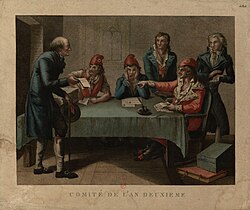Revolutionary sections of Paris

The revolutionary sections of Paris were subdivisions of Paris during the French Revolution. They first arose in 1790 and were suppressed in 1795.
History
At the time of the Revolution, Paris measured 3440 hectares, compared to the 7800 hectares of today. It was bounded to the west by the
In 1789, with a view to elections to the
After the Thermidorian Reaction on 27 July 1794, the sections still played an important role in suppressing the popular uprisings. In 1795, however, they were suppressed by the French Directory, which renamed the areas covered by sections as divisions, then quartiers.
Composition
Civil committee
Each section was headed by a civil committee of 16 members (elected by active citizens in the area covered by the section), the juges de paix (judges) and members intended to act as intermediaries between their section and the
On 9 August 1792 each section delegated commissioners elected by the active and passive citizens, as a replacement for the 'municipalité' of Paris. There were 52 of these commissioners in total (including
Revolutionary committee
Set up by a law of 21 March 1793, the initial task of the sections' revolutionary committees was surveillance on foreigners without interfering in the lives of French citizens. Their activities towards that end (often going beyond the limits the law of 21 March had placed on them) were enabled by the Law of Suspects of 17 September 1793. They also had the power to make lists and issue arrest warrants. They also had the right to deliver citizenship certificates, all in establishing a direct correspondence with the Committee of General Security.
Armed force
Paris's armed force was headed by a commander in chief and divided into 6 legions, each legion made up of troops from eight sections. The troops of each section had their own commander in chief, second in command and adjutant-major. The companies were made up of 120 to 130 men, being bigger or smaller according to their section's population. A company was commanded by a captain, a lieutenant and two 'sous-lieutenants'. Each section also had a company of artillery (60 men and 2 cannon each). In the Thermidorian Reaction of 27 July 1794, during the fall of
References
- ISBN 2-85565-552-8, p 265
